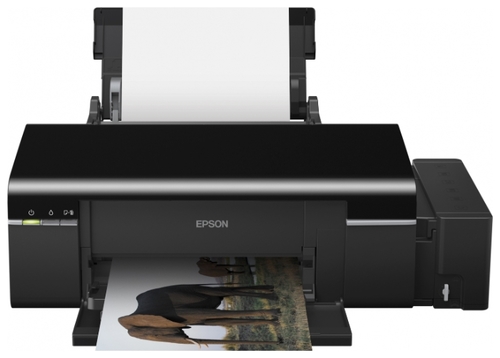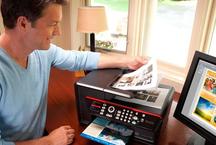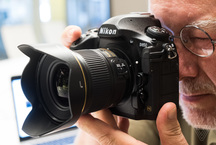
Specifications
| General characteristics | |
|---|---|
| Device | Printer |
| Type of printing | colored |
| Printing technology | piezoelectric jet |
| Accommodation | desktop |
| Printer | |
| Maximum format | A4 |
| Printing photos | there is |
| Number of colors | 6 |
| Minimum drop volume | 1.5 square |
| Borderless printing | there is |
| Maximum resolution for color printing | 5760x1440 dpi |
| Print speed | 37 ppm (b / w A4), 38 ppm (color A4) |
| Printing time 10x15 cm (color) | 12 s |
| Trays | |
| Paper feed | 120 sheet. (standard) |
| Paper output | 50 sheet. (standard) |
| Consumables | |
| Paper density | 64-300 g / m2 |
| Print on: | cards, tapes, labels, photo paper, CD / DVD, glossy paper, envelopes, matte paper |
| Resource color cartridge / toner | 1800 pages |
| Resource b / w cartridge / toner | 9900 pages |
| Number of cartridges | 6 |
| Continuous ink supply system | there is |
| Interfaces | |
| Interfaces | USB 2.0 |
| Fonts and languages of management | |
| PostScript support | not |
| Additional Information | |
| OS support | Windows, Linux, Mac OS |
| Power consumption (during operation) | 13 W |
| Dimensions (WxHxD) | 537x188x289 mm |
| Weight | 6.2 kg |
| Features | continuous ink supply system |
Epson L800 Printer Reviews
Virtues
- 1. The best price / quality ratio in the market of decent photo printers. Do not try to buy a printer with 4 colors !!!
- 2. Print quality at the level of professional photo salons with equipment for 1-1.5 mln. and simply divine compared to Krivorukov underground photo-chamber pits 3p per photo.
- 3. There are no problems with the purchase of original paint and paper. Be careful not to choose the original paper. There are a lot of good. Do not obviously take the toilet.
disadvantages
- My L800 doesn’t have them.
- And about others I can comment.
- WHAT YOU NEED TO DO, THAT WOULD NOT BE WEAKNESSES:
- 1. Wipe as necessary (1 time per 1000-1500 photo) rubber paper feed rollers, since they accumulate fine paper dust (or coarse, if you don’t cover the printer when idle). Especially a lot of fine dust on plain A4 paper and cheap photo paper. I wipe with cotton buds with vodka (although this is not correct, a more benign solution is better). At the moment of turning on, when the printer turns the rollers, just open the cover and gently insert the stick to each roller (top and bottom row). Do not put many sheets in the patch. Even clean videos don't like it. THIS WILL HELP TO ELIMINATE: distortions (white stripes), unwillingness to have thick paper, image blurring.
- 2. When selecting paper, use a millimeter ruler. FOR REFERENCE: 10x15 is not 100x150 mm. The original Epson paper is 101x152 mm., Many (not all) of the analogues are 97x146 mm. or even less. Do not dock the dimensions leads to overflow of paint for the edges of the paper, where it accumulates and smears the following sheets. The ruler WILL HELP ELIMINATE the blots on the edges of the photos.
- 3. Understand the print settings! Do not be just a user, be a professional. Understand in a simple box and get a quality result everyone can (sincerely hope). THIS WILL HELP TO ELIMINATE: all persimmon associated with printing quality paint on quality paper.
- 4. Do not print on the photo printer anything other than photos. Printing ordinary A4 documents (text, text + images) loosens the head of the printer, which leads to a sharp deterioration in photo printing. After 1 quickly printed leaf of text you have to calibrate the head for 15 minutes. THIS WILL HELP TO ELIMINATE: wear on the guide heads and leave unchanged high quality photo prints.
- 5. Do not buy non-original paint. THIS IS BAD for picture quality and spoils nozzles. You buy a printer for yourself, and not for the sale of pictures of 3 p. If not, then your right.
Comment
Printer took 2 years ago for 8500 p. Now it has not fallen in price and even increased. Consequently, there are no analogues and no worthy replacement.
PS: For every word written in a review, I answer with direct hands and experience in operating various printers. Apart from the factory defect, all other problems during operation are solved by careful and deliberate handling of the device. The printer is definitely not suitable for fans of 1 button (one click - 1000 photos). For you, there are photo salons. Those who are not afraid to translate a dozen two photos, but at the same time find out what's what - I RECOMMEND. You will not regret. Successes in endeavors. I hope I helped determine where to start.
Altukhov Alexander, 2014-07-19 Evaluation 5
Virtues
- CISS, drop size 1.5 PL, photo quality printing + low printing cost (if you take ink from other manufacturers, the cost approaches the cost of the sheet). Another big advantage compared to previous models is that the T50 and R270 had small cartridges, respectively, if you print (with CISS) for a long time, it can often report the replacement of cartridges, which interrupts printing and requires some manipulation. Thanks to the integrated CISS, this will not happen in the L800 and it will print for a long time before it signals replacement.
disadvantages
- Depending on the assembly, roofing felts, roofing felts, depending on some other conditions, can start typing quickly, and then slow down the printing speed (write on the forums about engine overheating). And at home there is an Epson T50 at it also a decrease in the printing speed is observed, at the end it barely moves the head at all (you have to install it at night), but at work exactly the same printer threshed without decreasing the speed. Now it is at work L800 and also reduces speed. If you print every day and in large quantities, then there may be a problem with the paper feeder (how to solve the problem on the Internet, but you already have to print 500 or more sheets per day and only after a couple of years can such a problem appear)
- Another drawback, or marketing ploy or protection, is the need to enter codes from Epson ink cans when they are poured. Those. if the cartridge runs out, you need to remove the cissf, inject ink and enter the code. But all this can be bypassed by searching for codes in the network (users post both codes and photos of cans to the network), it is even easier: you can download PrintHelp program and reset the ink level, then you don’t need to enter anything.
Comment
My experience: two R270 printers, two T50 and now L800. Generally, these are workhorses: R270 (standing in a photo center, making pictures, there were no problems), T50 (it was used in another job until the carriage drive belt was replaced (it began to break and the print was smeared on a piece of sheet), there was a problem with the paper feeder, but this is after 2 years of intensive printing as in a print shop :)), here in the L800 there will be the same problems if it is not spared, since it is made on the basis of the above models and still took it. It is generally ideal for home as at home in comparison with the above mode of operation it will last for many years. A good dopilenny model, not without marketing (ink codes), but this is nonsense. I advise!
ITA GROUP, 2013-08-28 Evaluation 5
Virtues
- Built-in CISS, low cost, excellent quality, more than 1000 prints 10x15 in fast print mode with photo quality.
disadvantages
- Not detected.
Comment
I use since February 2013 Printed on office paper, in the photo 200 g / m, 230 g / m, 260 g / m and 270 g / m in both A5 and A4 format - no complaints. I mainly use Lomond paper, as well as Flax Imitation Host and Magnetic Magnetic Host.
I do not know how it is on the original Epson paper, and printing black-and-white images on a scrap requires calibration skills, or a person with a tambourine. If there is neither one nor the other, I can advise the paper Prestige gloss 230 g / m - black-and-white shades reproduce perfectly well, provided that in the print settings you put a super gloss and shades of gray.
As for ink and refills ... I use only original ink and I do not understand those who pour all sorts of rubbish into the printer, and then whine - they say, it strips and does not work vaabsche: the cost price in native ink is about 5 rubles (I already printed 1000 snapshots 10x15, and the level of paint has not yet dropped to the lower mark in any capacity). Here, the truth is one thing. There are two features on the translucent capacitances of the CISS: one below and a triangle points to it, and the second, barely noticeable a couple of centimeters higher. So, the printer gives a warning when the ink level drops to this - imperceptible - lines.At this point, if printing occurs, the printer will stop and a warning will come out that the ink is running out. But. This warning has an item that allows you to continue printing until you decide to stop. Moreover, if you start to add ink at this moment (when their level has not reached the bottom mark with a triangle), you will find that there is excess ink left in the filling container. That is, the printer should be refilled when the ink level has reached the bottom mark indicated by the triangle.
And more. You can refuel individually any color (the most popular are yellow and pink). Pumping at the same time eats an insignificant amount of ink and is not equivalent to a lengthy initial pumping.
Midakov Evgeny, 2013-10-07 Evaluation 5
Virtues
- Built-in CISS, high print quality, good speed, price.
disadvantages
- High number of factory defects, very low warranty service life, a factor in the success of the work of the final service life.
Comment
The printer was operated daily for 2.5-2.8 years. In the course of operation, the following shortcomings were identified: the warranty period of the printer goes away without problems (de facto the warranty ends when you use the supplied ink, since there are approximately enough of them for 3000 printing pages under warranty), then the following problems can come out : the black threads in the photo are imperceptible from a distance, but on closer examination they spoil the overall look of the photo, the peculiarity is that they appear out of the blue and disappear into nowhere, it does not depend on the nozzle blockage, or on the print head calibration, and the paper or the amount of ink level, nor of the air into the ink tank by printing a striped image, followed by the same (again) is normal; hereinafter: printhead depressurization, i.e. mixing colors, especially clearly seen when testing a print of checking the status of nozzles, cannot be treated at all (you can blow nozzles, but it helps temporarily) and results in multi-colored photos; leakage of head nozzles (apparently occurs together with depressurization) one drop leaks and smears horizontally across the upper part of A4 sheet (sometimes there is - sometimes not, depends on the mode: weak in the photo, strong for the best photo, more ink flows); with a large run, the paper feed rollers get clogged up and it slips.
O +: very cheap printing with a quality no worse than a factory, using original ink and normal paper; do not save on consumables, because cheap paper will give shades of color, and non-original ink will finally finish the nozzles (the original costs 500 rubles a bottle, which consumes a long time, about 3000 sheets of A4 format photo mode on gloss); high speed relative to the earlier models of this company.
The result: a good, high-quality printing printer with low printing cost, even when using normal paper, for home printing, but with a low warranty period and many jambs after it.
Levandovsky Stanislav, 2014-08-03 Evaluation 4
Virtues
- availability of branded CISS.
disadvantages
- At primary pumping of ink there is a big expense, SNPCh is not finished, namely ventilation of barrels with ink, high cost.
Comment
Before that there was an Epson T50, it worked 4 years flawlessly. therefore decided to take the L800. I read the reviews, of course he doubted there would be problems, but decided to take it. Today I took it, brought it home, did everything as it was written in the instructions, waited until the ink pumping was over (and it lasts 20 minutes), looked forward to the nozzle check test and ofigel there was no test.
Did ink pumping, did not help. It seemed as if the printer was a month with low-quality ink and dried on the other head. In general, the guys at these printers, ventilation cfd is not finalized, but rather I just didn’t have it on any air conditioner. I removed the filler plugs, put adhesive tape on them, made a hole for ventilation and the printer came to life. Now everything is in order, the quality of the photo is satisfied.If anyone has similar problems, my advice can help you solve them.
Nagibin Anatoly, 2013-06-07 Evaluation 4
Virtues
- Factory SNPCH + all traditional advantages Epson
disadvantages
- Not
Comment
Immediately make a reservation - I was engaged and partially engaged in printing professionally. Factory SNPCH is super as it is not cool. And it is foolish to even try to compare the printer with the factory system with a similar one, but with a separately installed one. Who used both that and another - will understand. Who did not use - I tell.
In a regular printer with a separate set of CISS, the general algorithm for working with cartridges still remains: one of the colors has ended, spit out the half-printed photo, after resetting the chip it poured 1 ml of each color into the trash. If we recall that the native cartridge is 7.5 ml of ink, and without forgetting about such a phenomenon as fan cleaning, we have a smut every 100-150 photos of 10 * 15 cm. And probably a good third of the ink goes to the diaper.
On the L800, work with continuous feed is laid in the algorithm of its firmware itself. He stupidly prints pictures, hundred after hundred. Even when the donor runs out of ink (from the point of view of the printer), it does not spoil the sheet, but completes the task to the end. Even after the procedure of adding ink and entering the ID of the containers (no problem at all, full of codes in the internet), he DOES NOT do the cleaning. So all or almost all purchased ink goes into the business.
So the difference of 10 bucks (between T50 + CISS or L800) is absolutely not worth the loss of convenience, time and ink
Popoff Alexxx, 2014-01-14 Evaluation 5



